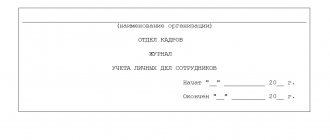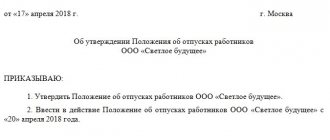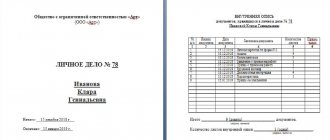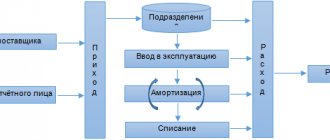What documents are included in a personal file?
It is recommended to place documents in your personal file in the following sequence:
- An inventory of the composition of the personal file, the sequence of all documents for easy searching.
- Application for a job.
- Employee profile with photos.
- Employment contract.
- A copy of the employment order.
- A copy of the certificate and diploma of education.
- Documents from the military unit, as well as confirming the absence of a criminal record.
- Registration at the place of residence.
- Characteristics from previous places of work, letters of recommendation.
An inventory of an employee’s personal file consists of a title, document number and index, inclusion date, sheet number and note. The note usually indicates which document is used - a copy or an original.
How to draw up an internal inventory of personal documents
Today there is no single, unified, mandatory sample of this document. Therefore, companies can use one of two options:
- each time, as needed, compose it in any form (which is inconvenient when there are a large number of personal matters),
- use a template developed and approved by the organization (it must be registered in the company’s accounting policies).
The document must contain a number of information:
- Business name,
- position and full name of the employee whose documents are described,
- list of described documents,
- a complete list of papers stored in the personal file (as well as their copies).
The inventory includes not only work books, education documents and certificates of advanced training courses, but also award sheets, copies of orders and instructions concerning the employee, lists of scientific works, information about academic degrees, etc.
It is best to enter basic information into a document in the form of a table.
It should also be noted that as the personal file expands, all new papers entering it should also be recorded in the inventory, as well as those that are removed from it or, conversely, returned to it (indicating the persons and the reasons why they needed).
How is it carried out?
All personal files of the enterprise are displayed in a special notebook or journal, where they are provided with a special number at the place of work. This journal contains brief information about the case: Full name. employee, date of transfer to the archive, start date of the case, number.
It is a mistaken belief that any HR department employee has access to employees’ personal files. This is not true, all power and ability to make changes is exercised by the authorized person. Changes may be the following: documents from the registry office, name change and others. In this case, copies of documents confirming the facts are entered into the personal file.
Proper storage of personal files is very important, because this is confidential information to which a limited number of people have access.
Storage periods for personal files:
- personal files of employees are kept for up to 75 days;
- personal files of senior positions can be stored for an unlimited amount of time;
The retention period begins from the moment the file is transferred to the archive.
Rules for maintaining and registration
In budgetary and commercial organizations, personal files can be kept for all employees or selectively. For example, only for managers or for management and financially responsible persons, etc.
The registration, management and storage of files are usually carried out by personnel services. This responsibility is assigned to them by order of the manager. How to properly prepare an employee’s personal file (sample) can be seen below.
A list of persons who are allowed access to personal files must be approved: to familiarize themselves with materials and receive them for temporary use to perform certain work.
According to the definition of GOST R 7.0.8-2013, “A file is a document or a set of documents related to one issue or area of activity, placed in a separate cover.” Accordingly, the registration of an employee’s personal file, a sample according to GOST, is, relatively speaking, a folder in which papers containing information about the employee, his work activity and length of service are filed.
The formation of a case begins from the moment an employee is hired. It is kept in a single copy. A separate folder is created for each employee. Information within the file is placed in chronological order. If copies of personal documents of employees are kept in the file, they must be properly certified. As a rule, all materials related to the employee’s work activities are attached to the personal file. They can be roughly divided into three groups. Documents related to:
- registration for work (consent to the processing of personal data, questionnaire, copies of educational documents, various certificates, employment contract, employment order, liability agreements, non-disclosure of confidential information, etc.);
- the labor process itself (additional agreements to the employment contract; orders on transfers, incentives, imposition of disciplinary sanctions, assignment of categories; certificates (conclusions) of periodic medical examinations (examinations); certification sheets; notifications; copies of documentation on advanced training, etc. );
- dismissal (resignation letter; dismissal order).
Conducting a case involves: entering into accounting documents records of all changes in biographical data and work activity, attaching incoming materials and their withdrawal, issuing information and certifying copies, filling out an internal inventory, periodically checking the state of affairs, closing and transferring to the archive, etc. d.
Personal files are subject to accounting and are registered in the appropriate journal. You can develop its shape yourself. Most often, case numbers, dates of their establishment, headings, and closing dates are entered in the columns.
Registration procedure
Since in any enterprise, due to the large number of employees, it is impossible to keep track of all documents and their flow, it is very important to follow all the rules of registration in order to avoid the loss of important information that may interfere with the organization of the work process.
Proper storage and registration of personal files of all employees greatly simplifies the task:
- For example, if the company is large enough and employs a large number of employees, their personal files should be placed in alphabetical order. This will make it easier to find the desired folder.
- The employee’s personal file should not contain more than 250 pages.
- The cover page should display only basic information about the personal file. This is your full name. employee and case number at the enterprise.
Personal files can be stored in the following ways:
- In alphabet order.
- By structural divisions of the company (departments).
- Numbering of cases by their numbers or assignment of numbers during registration.
Maintaining
The basis for compiling a list of personal files is the principle of chronology, and in accordance with it, all papers must be filed in the file as they appear or are received. After the dismissal of employees, all their personal files are closed in accordance with the requirements of office management rules and transferred to the archive. The files of employees who were in public service are kept in the personnel department for 10 years. This is due to the fact that when such an employee is transferred to a new place of duty, the case moves with him. The personal files of the remaining employees are transferred to the archive after a period of 3 years after the date of their completion.
The documents included in the case are considered important; an internal list (inventory) must be drawn up on them in the prescribed form, and their numbering is carried out separately. Before sending the file to the archive for storage, the number of its sheets is reflected in the attached certification sheet.
For each employee, a personal file is maintained as an independent package of documents. Only in storage conditions is it possible to sew several separate folders with personal files into a grouped order under one title page. In this case, the internal inventory of documents must contain a list of all personal files included in the work order, indicating the full name and sheet numbers of each package of documents.
In most cases, the completed cases are of significant size, and it is much more convenient to store each of them as a separate unit, rather than stitching them into thick and inconvenient bundles. At the same time, an independent personal file is maintained for each employee, as determined by regulations.
Sample
As stated above, only authorized employees have access to make changes to personal files.
The heading for the personal file is your full name. employee. Variations in the spelling of the surname or the woman's maiden name may also be indicated. For example: Bread (Kalinina) Elena Maksimovna.
When registering a personal file, it is allowed to accept documents that are dated earlier than the date the employee was hired. This issue is considered in individual cases, but, as a rule, it is resolved in favor of the employee.
The complete case form includes the following items:
- Design and entry of data on the cover of the folder (cover design will be discussed later).
- It is important to record the number of sheets in the case (no more than 250 pages).
- Preparation of the certification sheet.
- Internal inventory of documents in accordance with the apparent quantity collected, data verification.
- File filing, case binding.
- Entering the necessary information into the cover of the employee’s personal file.
It is very important to know which documents are filed and which are not. The case file includes only the most important and significant documents, which can be stored for up to 75 years. If there are documents about the beginning of vacation, applications for vacation at your own expense, and the like, then these documents are not included in the filing folder. They are added to the total quantity.
How much to store and where
In the HR department, employee files are kept throughout the entire period of their work in the organization. For these purposes, a special place is equipped to prevent access to them by third parties, as well as the possibility of their theft or loss. Typically these are locked safes or metal cabinets or rooms.
When an employee resigns, the personal file is closed. The case is closed - this means that it is completely processed and completed. In this case, first, an internal inventory is filed with a final record of the number of sheets and documents in it, and at the end - a certification sheet. The title page indicates the date of closure of the case (date of dismissal) and the period of its storage, which begins to be calculated from January 1 of the year following the year of closure.
Instructions for filling
After establishing an employee’s personal file, he must fill out a form. The questionnaire must provide comprehensive answers to all questions.
Laconic and clear answers without unnecessary fluff. After the questionnaire, you should place a photo of the employee. This should be a new photo, and not one where he is 18, when in fact a man of about 40 is standing in front of you. The autobiography must be compiled correctly and reflect all stages of the employee’s life. Educational institutions, interests, places of work and more.
Copies of documents on education or advanced training in certain areas must be certified first. When compiling a personal file, an employee is obliged to promptly report any changes (last name, first name, etc.).
The external characteristics of the employee are signed by the director of the enterprise, and the internal characteristics - by the head of the division or department of the company. All pages must be numbered.
Closing a personal file
If an employee resigns, the personal file is closed on the day of his dismissal. A closed personal file must be fully documented. To do this, you should check the presence of all documents and their location in the folder (documents should be arranged in chronological order), as well as the numbering of sheets (all sheets are numbered in Arabic numerals with gross numbering in the upper right corner of the sheet using a simple pencil or numberer).
A final record is drawn up for the internal inventory, which indicates in numbers and in words the number of documents included in it and the number of sheets of the inventory itself. The internal inventory is signed by its compiler. The inventory sheets are numbered separately from the personal file sheets. A certification sheet is drawn up on a separate sheet. It states:
- In numbers and in words the number of numbered sheets of the case.
- Number of internal inventory sheets.
- Features of the numbering of case numbers (the presence of lettered case numbers, missing numbers, numbers of sheets with pasted photographs, numbers of large-format sheets, envelopes with attachments and the number of sheets enclosed in them).
- The presence in the personal file of printed copies of brochures with the number of sheets in them, if they were not noted in the general gross numbering in the file.
The document certifying the case is signed by its compiler. All subsequent changes in the composition and condition of the personal file (damage, replacement of original documents) are noted in the certification sheet with reference to the relevant act. Next, the personal file is filed. At the same time, at the end of each case, a certification sheet is filed, and at the beginning of the case, an internal inventory is filed. If these documents were not filed with the case, then the inventory is glued to the inside of the front cover of the personal file, and the certification sheet is glued on top of the inventory at the top of the sheet.
Next, on the title page of the personal file, the date of its closure is indicated, that is, the date of issuance of the dismissal order and the period of its storage. The storage period is calculated from January 1 of the year following the year the personal file was closed.
According to Article 22.1 of the Federal Law of October 22, 2004 No. 125-FZ, the storage period can be either 50 years (if the personal file was created after 2003) or 75 years (if the personal file was created before 2003). Please note that if the personal file contains documents with different maximum storage periods (for example, for an order of employment it is 75 years, and for an order of dismissal it is 50 years), then we store the entire file according to the older period.
If there are unclaimed personal documents of the employee (identity cards, work books, military IDs), these documents are placed in an envelope, which is filed with his personal file. Envelopes with attachments filed in the case are numbered. In this case, the envelope itself is numbered first, and then each attachment in the envelope is numbered with a subsequent number. Personal files are transferred to the archive no later than three years after their completion in office work.
Sample title page design
GOST 17914-72 dated July 17, 1972 regulates the rules for registering personal files, they are as follows:
- At the top of the title page there may be information that is allowed to be filled out only by the municipal or state archive, these are codes, dates of submission of documents to the archive, and more.
- In the center of the title page, slightly indented from the top, you must indicate the name of the organization. As a rule, the abbreviated name of the company is written in this place.
- Below the name of the company, the department in which the new employee works is indicated.
- Then the case number is indicated, which is taken in brackets. It must be preceded by an index, also in parentheses.
- Then the title of the personal file is written. The last name, first name, and patronymic of the employee are used as the heading.
- The lower right corner of the title page is intended for information such as the date of hiring the employee, the day of dismissal, the storage period of documentation, the date of filing in the archive, and more.
Using the Network City system. Education
Information system “Network City. Education” (when mentioned - the system) allows you to organize the management of personal files of school employees in electronic format. The system generates a personal card of the T-2 form. It is possible to form a teaching portfolio.
Information about the employee is added to the system by sections:
- Basic information (employee details, position held);
- Identification documents (information about passport, military ID, etc.);
- Personal achievements (employee participation in events by year);
- Contact information (information about the employee’s contacts);
- Additional information (information about place of residence, employment, certification, etc.).
Thus, maintaining a school employee’s personal file in electronic form includes all the information necessary for the employer and eliminates the need to store copies of documents.
Summarizing
The procedure for creating and the composition of an employee’s personal file
* Due to frequent changes in legislation, information sometimes becomes outdated faster than we can update it on the site. * All cases are very individual and depend on many factors.
Basic information does not guarantee a solution to your specific problems. That's why FREE expert consultants work for you around the clock!
* Call the hotline: Moscow and the region - +7(499)350-84-28 St. Petersburg and the region Currently, there is no such document not only in unified forms, but also in recommended ones. The current legislation provides for the formation of LD only for the civil service, where the nomenclature and reserve of employees are formed.
The storage period for records depends on the category of employee and the storage period for the documents contained in the file.
Typically, this can be from 5 to 50 years. To register a personal file, you need: a folder - a binder, a hole punch and documents. If it is decided to store applications, orders and other office materials separately (often such documents remain in the accounting department), then copies are filed in the LD. The list of materials is given in paragraph 5 of Decree No. 640. After excluding the rules relating to the specifics of the civil service, the list is applicable to any other company.
The general requirements can be formulated as follows: The last to be filed are materials on the completion of work at this enterprise.
This could be a letter of resignation, an order to terminate an employment contract, an extract from the work record book, etc.
We recommend reading: Punishment for riding a motorcycle without a license
p. Upon completion of the formation of the personal file, the materials contained in the folder are stitched with a strong thread at the bottom of the pages, in increments of 1–1.5 cm. The sheets are numbered in pencil in the upper right corner. The title page contains the employee’s personal data and information about the period of his work at this enterprise.
A photograph is not a required element of the cover. The inventory is one of the main documents of the LD.
It is necessary to approach the preparation of the inventory in good faith, since it is this that allows you to quickly find the necessary documents, as well as check the completeness of your personal file. Only one LD can be opened per company employee. Collecting information by secret methods is punishable by law.
If you are engaged in maintaining employee records, then remember about the law on confidentiality of information. In cases where the charter of your enterprise stipulates the need to register LD, you should draw up a list of persons who have access to them.
The employee himself has the right to familiarize himself with his personal file. In the practice of large companies, employees are introduced to the LD without fail, upon receipt, as a rule, once a year. Personal records may not be disclosed to third parties except at the request of law enforcement agencies.
It is prohibited to store LD in branches that are not a legal entity and cannot be an employer. Personnel department inspectors may be subject to penalties in the amount of 500 rubles for each incorrectly completed document. But this applies only to unified forms, which do not include the personal files of employees.
There is a simple and effective way out of the situation. The electronic format for maintaining personal files reduces representation costs for staffing and eliminates many problems.
Results
Employees' personal files must contain an inventory. The inventory in the personal file is located at the very beginning. As the personal file is filled out, data on all new documents is entered into the inventory.
A personal file is a set of documents containing information about the employee and his work activities. Formed by the organization’s personnel service after publication.
Opening a personal file for an employee, as a general rule, is not mandatory, that is, there are no regulations obliging the employer to do this, with the exception of the Federal Law “On the Fundamentals of the Civil Service of the Russian Federation” (No. 119-FZ of July 31, 1995) , obliging the personnel service to maintain personal files for civil servants.
Moreover, in regulations, for example, “List of standard management documents generated in the activities of organizations, indicating storage periods,” mention documents that “are not included in personal files,” as well as “those that do not have a personal file.” Thus, the composition of the documents in an employee’s personal file is not regulated by Russian legislation and, according to established tradition (habit), we build on the accepted state record keeping system of Soviet times.
The documents included in the personal file can be formally divided into: 1. Documents provided by the employee and filled out by the HR employee when applying for a job, these include:
- personal ;
- copies of education documents;
- recommendations and characteristics;
- medical certificates;
- extract from the employment order;
- extracts from protocols on election to office;
- an extract from the protocol on the results of the competition for a vacant position;
2. Documents supplemented during employment:
- extracts (copies) from, and, translations and movements, etc.;
- copies of documents confirming changes in biographical data (marriage or divorce certificate, birth certificate of children, etc.);
- copies of documents on education and advanced training;
- memos, personal statements and explanatory notes;
- acts, notifications, etc.
3. Documents on termination of the employment contract.
All these documents have different statutory storage periods at the enterprise.
Based on the difference in the normatively established storage periods for various types of personnel documents, as well as the fact that information about the employee’s work activity is recorded in a personal card, it is recommended not to include copies of orders (extracts) on transfers and transfers, vacations, incentives, etc. .d.
Documents filed in the employee’s personal file during the period of his employment must be arranged in chronological order.
Copies of documents (extracts) must be certified by HR employees.
Documents of the personal file are filed in the “case” folder. In accordance with the definition enshrined in GOST R 51141-98: “BUSINESS” is a set of documents or a document related to one issue or area of activity, placed in a separate cover.
The cover of the “case” is designed in accordance with the requirements of GOST 17914-72 “Cover of long-term storage cases. Types, sizes, technical requirements."
An internal list of documents is drawn up for a “case” opened against an employee.
Employees must be periodically familiarized with their personal files (usually once a year).
An internal inventory of documents is compiled only for those files that are subject to full registration, as well as for personnel files, regardless of their storage period. At its core, the inventory is a table of contents for each volume. This means that if, for example, the orders for the main activities amounted to three volumes, then three inventories will have to be made. The finished inventory is located at the beginning of the volume and stitched into the cover along with the documents.
Let's remember which cases are subject to full registration (a separate article about this can be found at the link). This:
- cases with a storage period of more than 10 years;
- files on personnel, and it doesn’t matter how many years they need to be stored, 5 or 50.
Inventory of documents in the employee’s personal file
- a sample of this register is presented in this article - is provided for by the current archival rules.
Read more about the meaning and procedure for filling out the inventory below. The inventory of documents is drawn up in the form of a register, into which information about the documentation that formed/amended the personal file is entered in chronologically strict order.
We will tell you in this article how to organize HR records management in a company from scratch. Personal files of employees in non-state (non-municipal) companies are classified as archival documents of private property (subclause 3, part 1, article 3 and subsection 3, part 1, art.
9 of the Law “On Archival Affairs” dated October 22, 2004 No. 125-FZ).
As for their shelf life, it is:
- at least 75 years old, if they were created before 2003 (subclause 3, clause 1, article 22.1 of law No. 125-FZ),
- at least 50 years if they were created after 2003 (subclause 3, clause 2, article 22.1 of law No. 125-FZ).
Based on the above, it is clear that such a register as an inventory for documents with a very long shelf life must be present in the file. To complete the inventory, a unified form is provided, approved by the Archival Rules (Appendices 2, 10).
- serial number;
- index;
- date of compilation (or deadlines and storage period);
- title;
- sheet numbers.
For forms and types of orders for personnel, please follow the link.
The inventory must be signed by the compiler (usually the same employee who maintains the personal file) with a mandatory decoding of his position and full name. The date of compilation must be indicated - it is entered upon completion of filling out the personal file.
We recommend reading: Date of receipt of goods for auction 12
In order not to make mistakes when filling out the inventory, we suggest that you familiarize yourself with the sample, which shows the correct completion of information about personnel documentation.
You can view the above inventory on our website: Employees’ personal files must contain an inventory.
Employee's personal file
In addition, all of them must be numbered, described, and stitched.
The inventory in the personal file is located at the very beginning. As the personal file is filled out, data on all new documents is entered into the inventory. Be the first to know about important tax changes. Have questions? Get quick answers on our forum!
At the bottom, the number of documents and inventory sheets is indicated in words and numbers. Further, all information is certified by a signature with a transcript of the person in charge and the date is indicated. A sample inventory of a personal file can be downloaded here: An organization’s order providing for the establishment of personal files for employees must detail the procedure for their registration and accounting. As a rule, a book or journal of personal affairs is started.
In it, in order, the newly created business is assigned an enterprise number, which is then affixed directly to it.
Numbering of cases is carried out only according to this journal.
Any changes to a personal file can only be made by an employee appointed by order, and in his absence, no one, or an acting person temporarily appointed by order of the manager.
It is recommended to make corrections by analogy with correcting data in work books.
Registration of personal files of employees in preschool educational institutions
The document is generated when an employee is hired. Experts will tell you which documents can be stored in it and which cannot.
Download documents on the topic
How to register an employee’s personal file
Having an accessible and organized source of information about each working specialist at hand is very convenient. In state and municipal service, as well as in relation to military personnel, it is necessary to maintain the employee’s personal file. Other employers have the right to refuse this optional but practical form of systematization of all data about each employee.
To create an employee's personal file, first determine which documents are allowed to be stored in the folder and which are strictly prohibited.
After hiring a new specialist, create a separate folder where you include the appropriate range of documents. As you work, simply add new documents to the folder that are directly related to the employee’s work.
Place all documents in a certain sequence. In general, keep all folders in the personnel department.
Rules for civil servants
What to include in an employee’s personal file, what documents should be in it, is not defined by law. An exception is made only for government employees.
Cases are opened against them without fail, including in folders the relevant documents, personal data, and a number of other information about entry into the civil service, its completion, and termination.
This is necessary to ensure the activities of the government agency, taking into account Part 3 of Art. 42 of the Law on Civil Service.
Rules for commercial organizations
In commercial sector organizations, the procedure for conducting office work, designing and storing folders for employees’ personal files is determined by local regulations.
What should be in the folder
- internal inventory of all case documents;
- personal sheet for personnel records;
- questionnaire;
- addition to the personal sheet for maintaining personnel records;
- employee's autobiography;
- completed application for employment;
- employee job description;
- characteristics obtained and letters of recommendation provided;
- personal statements submitted by the employee;
- an employment contract (EA) and executed additional agreements to it;
- copies of all personnel orders in relation to a specific specialist;
- certification sheets;
- results of completed medical examinations;
- reviews of officials about the specialist;
- document certifying the case.
During the entire period of the employee’s work, the personnel officer must update the folder with new documents that are directly related to the employee’s work. The last document in the folder will be a copy of the dismissal order.
How to file an employee’s personal file: sample
Download a set of documents for registration
Accountant V.N. was appointed responsible for maintaining personnel records in the organization. Zaitseva. She filled out the personal file of the employee - chief accountant A.S. Glebova.
Cover page of the employee's personal file (sample)
View sample
The document included an internal inventory, an employee’s questionnaire, a personal sheet for personnel records, an addition to it, and a certification sheet.
What documents should not be placed in employee personal file folders?
Do not store documents in the folder that are not directly related to the employee’s work.
When conducting business, comply with the requirements for the protection of personal data. It is not safe to place copies of personal documents required for employment in the employee’s personal file (sample). When conducting an inspection, Roskomnadzor may regard this as a violation of the rules for processing and storing personal data. Read more: Roskomnadzor inspections in 2021
Collect and process personal data in accordance with established rules. For example, when applying for a job, you only have the right to ask the applicant to show his passport, military ID, diploma, and so on to the personnel service.
Based on them, enter all the information into the card, after which return the original documents to the applicant.
Such rules are established by Article 65 of the Labor Code of the Russian Federation (resolution of the Fifteenth Arbitration Court of Appeal dated March 14, 2014 No. A53-12557/2013).
Exceptions are established for the state and municipal sectors. The folders include a number of documents, including photocopies of passports. Reason: Regulations approved by Presidential Decree of May 30, 2005 No. 609.
If you decide to store photocopies of documents in employee file folders, obtain their consent not only for processing, but also for storing copies of the relevant documents.
The consent must indicate the specific purpose for storing photocopies of documents. The HR officer should check the regulatory justification for storing such photocopies.
Judicial practice shows that it is impossible to store copies of personal documents of employees unless there are sufficient grounds for this.
★ Consent to the processing of personal data: download
Attention!
Consider what should be in the employee's personal file. If photocopies are kept in a folder without a reason, purpose or consent obtained, the organization may be fined a large amount upon inspection. Reason: Article 13.11 of the Administrative Code. These copies will be required to be destroyed immediately.
If upon review it is determined that copies are still on file, they must be destroyed within 30 days after the purpose of processing has been achieved. For example, the folder contains a child’s birth certificate, and the benefit has already been paid. The procedure for destroying such documents is not established by law. The employer has the right to determine it independently.
Registration of an employee’s personal file: sample according to GOST. Internal inventory of documents
When you design a folder, immediately make an internal inventory of it. Do this rationally when hiring an employee. File all the cases and describe them.
Add an inventory as new documents arrive in the folder until the employee leaves. If the files were filed without an inventory, make one and stick it on the inside of the cover. This procedure is specified in clause 4.30 of the Rules, approved by order of the Ministry of Culture dated March 31, 2015 under No. 526.
The procedure for maintaining personal files of employees is established by Appendix No. 27 to the Rules, approved by order of the Ministry of Culture dated March 31, 2015 No. 526.
The internal inventory is signed by the employee who is appointed responsible for its preparation. Before submitting the file to the archive, indicate the number of documents in the file and the number of inventory sheets.
Enter the final entry on the inside of the inventory. Such rules are established by the specified Appendix.
Sample internal inventory
See the example and use it in your work
★ An expert from the magazine “Personnel Business” will tell you how to correctly draw up and use a personal file inventory in your work. From the article you will learn whether all documents need to be entered into a personal file and how to enter information into an already generated inventory.
How to prepare documents when maintaining personal files of employees
Follow simple rules to keep your papers organized.
Rule 1
. Arrange documents in your file as they become available in chronological order.
Rule 2
. The folder should contain no more than 250 sheets. If there are more of them, it is necessary to prepare the second volume taking into account clause 4.20 of the Rules, approved by order of the Ministry of Culture dated March 31, 2015 under No. 526.
Rule 3
. Number all sheets of your personal file in Arabic numerals using a simple graphite pencil or numberer. Please note that ink and colored pencils cannot be used.
Rule 4
. Place numbering on each sheet. There is no need to number all pages. Number the internal inventory separately from the documents stored in the folder.
Where and how long to store folders for employee personal files
Keep folders in the HR department for all employees who currently continue to work in the organization.
Transfer to the archive all the files of those who have already left the company. To make the transfer, sew the employee’s personal file with four punctures, placing it in a hard cover, or bind it.
Everything needs to be done so that each sheet can be easily read, and if necessary, view the relevant details. Remove staples from all documents before filing or binding. At the beginning, file the form with the internal inventory, and at the end, place the certification sheet.
Certification sheet for the case
View and use
On the cover, write down the date when you finished teaching it. Indicate the number of sheets, take into account all sheets without exception, including the inventory and the certification sheet. Put the expiration date on the cover.
Shelf life
Keep files that were completed before January 1, 2003 for 75 years.
Keep files that were completed after January 1, 2003 for 50 years.
Maintain personal files of managers at all times.
Keep for at least 75 years the folders that were created during the period of civil service that is not the state civil service. They must be stored regardless of the date of creation.
★ An HR System expert will tell you how to create and store an employee’s personal file. The article presents the procedure for maintaining and storing files, and provides answers to the most common questions asked by personnel officers.
How to register a personal file for an employee of a budget organization
Not a day without instructions × Not a day without instructions
- Services:
In the article we talk about the rules for registering and maintaining personal files: how to register, where and how to store, who is responsible.
January 28, 2021 Author: Maya Polozkova Maintaining personal files of employees is required by law only in state and municipal organizations.
The law also determines the requirements for their registration. But such a document will be of practical use in any organization.
Therefore, for the convenience of collecting, processing and storing information, many prefer to maintain personal files of all employees or individual categories. Let's look at this topic in more detail. First of all, you should develop a local regulatory act (regulations or instructions for maintaining personal files), which prescribes the rules and requirements for the design, content, maintenance, storage of personal files, etc. When drawing up








